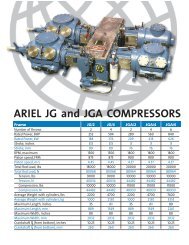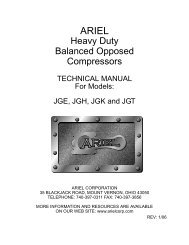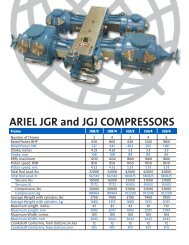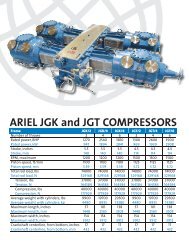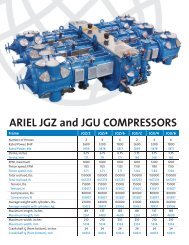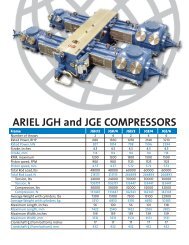Heavy Duty Balanced Opposed Compressors
Heavy Duty Balanced Opposed Compressors
Heavy Duty Balanced Opposed Compressors
Create successful ePaper yourself
Turn your PDF publications into a flip-book with our unique Google optimized e-Paper software.
FOR MODELS: JG AND JGA SECTION 5 - MAINTENANCE<br />
!<br />
CAUTION<br />
CROSSHEADS ARE HEAVY. CARE MUST BE TAKEN WHEN<br />
HANDLING TO AVOID PERSONAL INJURY. THE WEIGHT OF<br />
EACH CROSSHEAD IS LISTED IN THE BALANCE SHEET<br />
THAT COMES IN THE MANUAL WITH EACH COMPRESSOR.<br />
1. Remove crosshead guide side covers and cylinder head.<br />
2. Move the crosshead to its inner dead center position and back off, but do not<br />
remove, the crosshead nut set screws. Loosen the crosshead nut with the special<br />
slugging Peg or Open End Wrench shown in Figure 7-1: on page 7-3,<br />
depending on nut style, and a babbitt or plastic-faced slugging hammer.<br />
3. Use the Piston Nut Spanner (Torquing Adaptor) shown in Figure 7-1: and a<br />
speed wrench to screw the piston rod out of the crosshead. The two dowels on<br />
the Adapter fit holes in the piston nut. Turn the crosshead nut off the piston rod.<br />
Push the rod end forward to the edge of the packing to provide a clearance for<br />
crosshead removal.<br />
4. With the crosshead in its outer dead center position, remove the crosshead pin<br />
thru bolt, lock nut, end-plates and pin.<br />
5. Turn the crankshaft to its inner dead center position. Move the crosshead to its<br />
outer dead center position to be free of the connecting rod. Make sure the connecting<br />
rod does not drop and damage the crosshead guide surface.<br />
6. Roll the crosshead 90 degrees and remove it through the guide opening.<br />
7. Check the crosshead pin to bushing clearance. (See Table 1-2 on page 1-8.)<br />
Wear on the pin can be determined by a visual inspection. Replace the pin if<br />
necessary. If the bushings need to be replaced, hacksaw or file to within 1/32<br />
inches (1 mm) of their thickness. They can be easily drifted out. A press will be<br />
needed to install new bushings. The bushing can be installed in the crosshead<br />
by cooling the bushing in a dry ice and alcohol solution. The bushing needs to<br />
be left in the solution long enough to reach the same temperature as the solution,<br />
about -120° F (-85°C). DO NOT TOUCH COLD SURFACES WITHOUT<br />
PROPER INSULATION TO PREVENT INJURY. Bronze crossheads do not<br />
have bushings; if the crosshead pin bearing area is worn, these crossheads<br />
should be replaced.<br />
NOTE: THE SIDE OF THE CROSSHEAD RECEIVING THE NEW BUSHING SHOULD BE<br />
SUPPORTED DIRECTLY TO PREVENT POSSIBLE CRUSHING OF THE<br />
CROSSHEAD BY THE PRESS. (SEE FIGURE 5-3:)<br />
ABSOLUTE CLEANLINESS IS REQUIRED OF BOTH BUSHING AND CROSS-<br />
HEAD TO PREVENT DIRT FROM ACCUMULATING BETWEEN THE BUSHING<br />
AND CROSSHEAD BORE.<br />
8. Visually inspect the shoe surfaces for scoring. Since they are constantly lubricated<br />
under pressure during operation, there should be virtually no wear.<br />
PAGE 5 - 6 11/01





